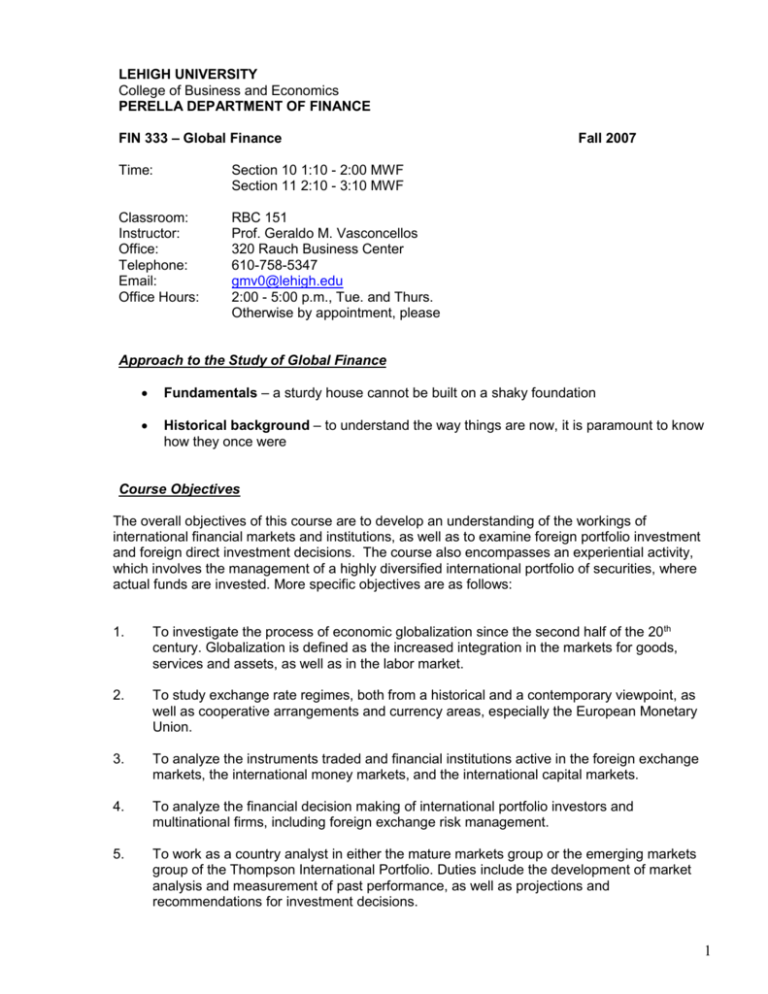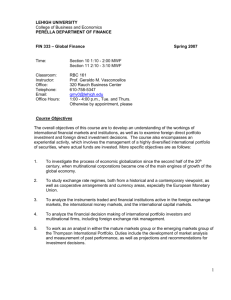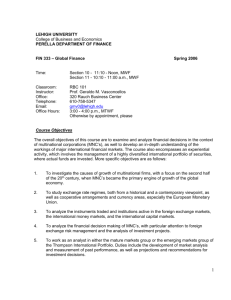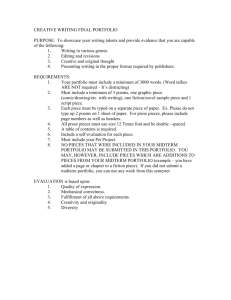
LEHIGH UNIVERSITY
College of Business and Economics
PERELLA DEPARTMENT OF FINANCE
FIN 333 – Global Finance
Time:
Section 10 1:10 - 2:00 MWF
Section 11 2:10 - 3:10 MWF
Classroom:
Instructor:
Office:
Telephone:
Email:
Office Hours:
RBC 151
Prof. Geraldo M. Vasconcellos
320 Rauch Business Center
610-758-5347
gmv0@lehigh.edu
2:00 - 5:00 p.m., Tue. and Thurs.
Otherwise by appointment, please
Fall 2007
Approach to the Study of Global Finance
Fundamentals – a sturdy house cannot be built on a shaky foundation
Historical background – to understand the way things are now, it is paramount to know
how they once were
Course Objectives
The overall objectives of this course are to develop an understanding of the workings of
international financial markets and institutions, as well as to examine foreign portfolio investment
and foreign direct investment decisions. The course also encompasses an experiential activity,
which involves the management of a highly diversified international portfolio of securities, where
actual funds are invested. More specific objectives are as follows:
1.
To investigate the process of economic globalization since the second half of the 20th
century. Globalization is defined as the increased integration in the markets for goods,
services and assets, as well as in the labor market.
2.
To study exchange rate regimes, both from a historical and a contemporary viewpoint, as
well as cooperative arrangements and currency areas, especially the European Monetary
Union.
3.
To analyze the instruments traded and financial institutions active in the foreign exchange
markets, the international money markets, and the international capital markets.
4.
To analyze the financial decision making of international portfolio investors and
multinational firms, including foreign exchange risk management.
5.
To work as a country analyst in either the mature markets group or the emerging markets
group of the Thompson International Portfolio. Duties include the development of market
analysis and measurement of past performance, as well as projections and
recommendations for investment decisions.
1
Text and Readings
The textbook for this course is Multinational Business Finance, by David K. Eiteman, Arthur I.
Stonehill, and Michael H. Moffett, Pearson Addison-Wesley, Eleventh Edition, 2007. In addition
to the textbook chapters and questions at the end of the chapters, I will assign several readings
during the term related to current issues in international investments, multinational business
finance, and international financial markets.
As a student of Finance, you must keep abreast of recent developments. At a minimum, you
need a daily source of financial information. Accordingly, a financial newspaper, such as The
Wall Street Journal or the Financial Times, is required reading for this course. You can also find
in-depth analysis, including comprehensive surveys of major topics from time to time, in The
Economist, published weekly.
GRADING SYSTEM
The grades for this course will be based on three midterm examinations and a term project, as
well as attendance and contributions in class. The dates for the examinations are as follows:
1st Midterm Exam:
2nd Midterm Exam:
3rd Midterm Exam:
Wednesday, September 26
Wednesday, October 24
Wednesday, November 28
The table below shows the percentages of the overall grade which are accounted for by the
different graded assignments. Please note that attendance is required in this course. I will call
attendance in most meetings in order to enforce this requirement.
Assignment
Percentage of final grade
1st Midterm Exam
20%
2nd Midterm Exam
20%
rd
3 Midterm Exam
20%
Term Project
30%
Attendance and participation
10%
100%
THE THOMPSON INTERNATIONAL PORTFOLIO
The Thompson International portfolio (hereafter TIP) is an integral part of this course. The
portfolio is managed by the students; I function as a faculty advisor and trustee. Each student
will be a country analyst and will cover a country that is either part of the portfolio or a prospect.
The portfolio is organized in four units: a Global Allocation Group, a Mature Markets Group, an
Emerging Markets Group, and a Special Projects Group. For a comprehensive view of the
portfolio, visit the web site at www.lehigh.edu/~intip/. The term project consists of an analyst’s
report and recommendation (please see Appendix A for the Market Report Guidelines). The
research in the report will focus on the market as a whole; however, a discussion of specific
industries and companies will frequently be necessary for completeness. Analysts will work in
pairs. The next round of investment decisions will use the input from this research, i.e., its
conclusions and recommendations.
The due date for this project is Friday, December 7 (last day of classes). Your project must have
a professional presentation. You are encouraged to consult reports from financial institutions
such as Goldman Sachs, Morgan Stanley Dean Witter, Merrill Lynch, Salomon Smith Barney,
2
and Lehman Brothers to develop ideas for items to include in your project. Appendix A contains
guidelines for the term project, as mentioned above.
DAY-TO-DAY MATTERS
A typical class meeting will have a lecture-discussion format. We will cover material from the
textbook, discuss assigned readings, and analyze some end-of-chapter questions and/or
problems, as well as devote a sizable amount of time to a free-form discussion of current events
pertaining to or affecting multinational corporations and the international financial markets (see
Appendix B for a list of www sites of interest). In addition, I will frequently ask the analysts to
make brief oral presentations concerning the current status of their research.
Your participation in the class discussion is very important for the success of the course. Your
questions are always welcome, including questions about current events which are relevant for
the course but not necessarily related to the topic of a particular class. If I have a meaningful
comment to offer on the spot, I will offer it; if not, I will look into the issue and get back to it in the
next meeting.
TOPICS AND ASSIGNMENTS
The assignment of a chapter or chapters from the textbook includes not only reading the body of
the chapter, but also attempting to answer the questions and/or solve the problems at the end of
the chapter. Use your common sense when deciding how many or which questions or problems
you wish to tackle. From several chapters, I may point out in class that a particular subset is of
interest; that should be interpreted as a minimum requirement, as opposed to the only
questions/problems you need to pay attention to.
You will find out that not all the material in the chapters assigned will be covered in class. That is
by design; I intend to use the time in class to discuss the fundamental concepts. You are still
responsible for all the material in the chapter. I am available to discuss your questions in my
office hours or by appointment.
1. Introduction
- Globalization, the International Environment, and Corporate Governance.
- Eiteman, et al.: Chapter 1.
2. The International Financial Environment
a. The International Monetary System
- Eiteman, et al: Chapter 2.
b. Balance of Payments
- Eiteman, et al.: Chapter 3
c. The Foreign Exchange Market: Spot Market and Forward Market.
- Eiteman, et al.: Chapter 6
d. International Parity Relationships
- Eiteman, et al.: Chapter 4
3
e. Foreign Currency Derivatives
- Eiteman, et al.: Chapter 7
f. Forecasting Exchange Rates
- Eiteman, et al.: Chapter 5
g. International Banking and the Eurocurrency Market
- Eurocurrencies – pp. 22, 38-40.
- Eurobanks – p.38
- LIBOR – pp. 39-40.
- Eurodollars – pp. 57-58.
- International loans – pp. 444-445.
- Eurocommercial paper – pp. 445-447.
- Branch banks – p. 735.
h. International Capital Markets
- Eiteman, et al.: Chapter 12, Chapter 13
3. Foreign Portfolio Investment
a. International Portfolio Diversification
- Eiteman, et al.: Chapter 15
4. Foreign Direct Investment
a. Political Risk
- Eiteman, et al.: Chapter 17
b. Multinational Capital Budgeting
- Eiteman, et al.: Chapter 18
5. Foreign Exchange Risk Management
a. Transaction Exposure
- Eiteman, et al.: Chapter 8
b. Operating Exposure
- Eiteman et al: Chapter 9
c. Translation Exposure
- Eiteman et al.: Chapter 10
4
APPENDIX A
Market Report Guidelines
• Recommendation (one paragraph)
• Executive Summary
1. Country Overview
• Demographic Data
• Political Organization
• Recent History (related to international investments)
2. Macro Fundamentals
• Structure of the Economy
• Size and Importance of the Agricultural, Manufacturing, and Service Sectors
• Monetary and Fiscal Policy
• Interest Rates and Inflation
• Balance of Payments
3. Micro Fundamentals
• Regulation of the Labor Market, Major Industries, Competitiveness
• Regulatory System, esp. regulation of the financial system (i.e., SEC-type regulations
or self-regulation)
4. Financial System
• Structure (banks, exchanges, futures and options markets)
• Central Bank
• Major Stock and Bond Markets
5. Opportunities for Foreign Portfolio Investment
• Major Companies
• Restrictions to Foreign Portfolio Investment
• Different Opportunities for Foreign Portfolio Investors (e.g., ADRs, mutual funds,
closed-end funds, ETFs)
6. Market Performance
• Over a Period of Time (Mature Markets and Emerging Markets)
• Comparison to Benchmarks (e.g., MSCI Mature Markets EAFE Index, and MSCI
Emerging Markets Free Index)
• Volatility of Returns
7. Current Position
• Fraction of TIP’s Assets Accounted for by the Market (if any).
8. Summary and Outlook
5
APPENDIX B
www Sites of Interest
Theses web sites contain abundant information about foreign economies and markets. They
should be very useful as a starting point for research on your term project, as well as other
aspects of foreign countries that may be of interest to you.
1.
The British Broadcasting Corporation (BBC) – www.bbc.co.uk
2.
Bloomberg - www.bloomberg.com
3.
The Central Intelligence Agency (CIA) - www.odci.gov/cia
4.
The Economist – www.economist.com
5.
European Union (EU) - www.europa.eu.int
6.
The International Monetary Fund (IMF) - www.imf.org
7.
The Organization for Economic Cooperation and Development (OECD) www.oecd.org
8.
The United Nations - www.un.org
9.
The U.S. Dept. of Commerce - www.doc.gov
10.
The U.S. Dept. of State - www.state.gov
11.
The World Bank (WB) – www.worldbank.org
12.
The World Trade Organization (WTO) – www.wto.org
6









